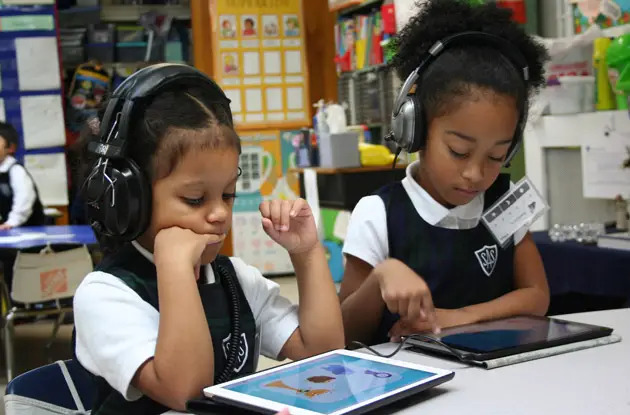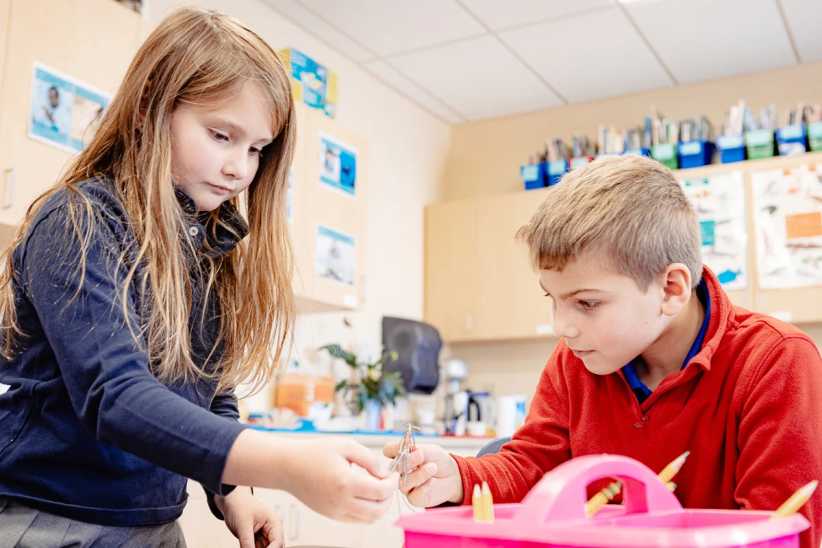Blended learning is a bold, new approach to education, in which technology is fully integrated with traditional teaching. St. Ann, a school in East Harlem, adopted this education trend in its classrooms and saw numerous benefits—both for the students and the community.
Behind Biondo, a digital timer is set for 30 minutes. When it goes off, the students rotate between the three ‘stations.’ Biondo remains seated and quickly begins teaching the next group’s lesson.
Class at St. Ann looked very different four years ago, before Principal Hope Mueller came on board and instituted a blended learning program—one in which a portion of learning is done online, and data generated is used to track students’ progress and refine lesson plans and other teaching strategies. At the time of her arrival, Mueller says, the school was plagued by behavioral problems, and test scores were stagnant. “The faculty and I recognized something wasn’t working and we kind of brainstormed and thought about the fact that we were not meeting the needs of every child,” she shares.
Mueller had gone to a few conferences and heard about blended learning and how the teaching style could possibly help students, so the faculty agreed to try it. At first the school made do with its limited tech gear, but soon won a grant for equipment (including the Chromebooks), better Wi-Fi, and staff support.
The new strategy has paid off. In its first year after implementing blended learning, St. Ann saw a 28-percent increase in the number of students passing the state English Language Arts test and a 5-percent rise in those passing the state math exam, far exceeding Mueller’s goal of a 3-percent increase in both areas. In addition, “we saw behavior concerns drop to almost nothing,” she says. “We saw morale go through the roof with everybody in the community, and enrollment go up for the first time since 2006.” Last year, St. Ann was 1 of 11 schools to win a Blackboard award for outstanding schools in New York City. It was also named one of the 85 schools in the country worth visiting by gettingsmart.com, a design firm focused on innovations in learning.
A Rich Blend of Digital and Traditional Learning
Kimberly Greene, Ed.D., an associate professor of education at Brandman University in Irvine, CA, and an expert on educational technology, says blended learning is “where there is a formal electronically mediated component. It’s a formal component, not the occasional ‘here, watch this video and we’ll talk about it in class.’” In other words, tech is integral to the teaching process.
A growing number of schools are adopting some type of blended approach. According to a 2015 report by the Center for Digital Education, 41 percent of K-12 schools surveyed offered blended and virtual (online) learning classes, and 55 percent of K-12 schools surveyed provided personalized learning, which is learning tailored to an individual student’s particular needs. Personalized learning goes hand in hand with blended learning.
“A lot of times I think about blended learning as a way to allow computers to do what computers do well, which is delivery of standardized lessons in some ways, and using data to personalize but [also] to free teachers to do what only humans can do,” says Michael Horn, co-author of the book Blended. “And that’s, you know, spend a lot more time on rich feedback. The point of blended learning is to increase the quality of those human interactions.”
St. Ann utilizes quite a bit of data to personalize lessons for its students. Using the i-Ready software, teachers can check students’ progress on virtual lessons as frequently as desired. The program automatically uses the data to personalize the lessons each student receives next. The teachers use that data to create their own lesson plans as well, and to decide how to group students for station rotation.
“Before we had this [approach], basically how you get data from students [is] you’re giving them quizzes or tests or you’re seeing how they act during class, seeing if they can answer questions. But this gives us data on how they’re doing each day in real time,” says Karen Doyle, St. Ann’s Blended Learning Coordinator and a STEAM (science, technology, engineering, arts, and math) teacher.
While St. Ann utilizes the station rotation model of blended learning, this is just 1 of 3 major blended-learning approaches used in K-12 education. In 2013, when the Center for Digital Education surveyed schools that have embraced digital learning in some way, it found that roughly equal percentages of respondents used station rotation (38 percent); a “flipped” classroom model, in which instruction is offered outside the classroom—often online—and projects traditionally considered to be homework are done during class time (43 percent); or a mixture of online and traditional classes (43 percent).
|
|
|
Two kindergarteners at St. Ann focus on their lessons in i-Ready. |
RELATED: Is Homework Necessary?
The Challenges of Implementing Blended Learning
Although blended learning can be beneficial, it also can be tricky to implement. “One of the most important things I will tell teachers…is that they need to walk around their rooms first thing and find the [electrical] outlets,” Mueller says. If a school’s building is old, as St. Ann’s is, many of the outlets may not work. In some of St. Ann’s classrooms, the only functional outlet was located where the teacher’s desk had always been, which meant that the desk had to be moved to make room for the Chromebook cart.
Even harder than rearranging furniture, however, was reframing staffers’ mindset as to what instruction could look like. “In the beginning, I was the one always complaining, ‘I can’t do this, I’m not a technology person,’” says first-grade teacher Stephanie Gueits-Marrero. “So for me, it was challenging to transition to this blended learning.”
Doyle adds that it’s also very difficult for teachers to carve out time to plan for blended learning. “You have to invest a lot of time and planning up front, and in the very first year we really didn’t have extra time built into the schedule,” Doyle notes. She explains faculty has to spend ample amounts of time sifting through student data on the computer software, then must come up with lesson plans for every group they’re going to see in their station rotation.
Last of all, schools may struggle with the price tag for the necessary tech tools. “One of the other most difficult things [was that we had to] get this new infrastructure, these Chromebooks. We got a grant that was very substantial,” Mueller says. “If we didn’t have that support from the Archdiocese and these generous donors, we would not have been able to do what we’ve done.”
Remarkable Ripple Effects of Blended Learning
Despite the challenges, St. Ann’s faculty wouldn’t go back to a traditional curriculum. “No. I think I like this way of teaching better,” says Gueits-Marrero—this despite her early resistance. “I think it’s more fun for the students too. They’re not stationed at one desk all day long. It’s helping them. The scores show their improvement.”
She describes one of her success stories, a student who came into her first-grade class on a pre-kindergarten level in reading and a low kindergarten level in math. But by the end of the school year, she was already on a second-grade reading level. Gueits-Marrero says this student is continuing to do well now.
Camron Campbell, a 14-year-old eighth-grader, is also benefiting tremendously from the new approach. “It’s a little emotional for me because my son struggled so long and felt so bad about himself,” says his mother, Antonia Campbell, remembering the years before the curriculum switch. Now, however, Camron “has just been excelling with this blended learning,” she says.
In fact, Principal Mueller says the new style of instruction has improved the climate of the entire school, and the surrounding community. Students and parents now trust the faculty and staff more. Because of the improved school climate, Mueller says faculty members have started facilitating after-school extracurricular activities, despite the fact that St. Ann is not able to pay them a salary for doing so. “The goal originally was just to help the kids academically,” she notes. “And it changed everything. If we had not started with blended learning, I don’t think any of these things would have happened.”
Blended Learning Gone Bad
St. Ann has had tremendous success with blended learning, but when schools don’t implement the approach properly, they run the risk of having it backfire. One common mistake some schools make, Horn says, is assuming technology has replaced the teacher and that the majority of a student’s day will be spent on the computer.
Another way schools get blended learning wrong “is they’re using it more as maybe a replacement for a textbook,” Horn explains. “But they’re not really personalizing that learning, and developing strong cultures around starting to help students own what they’re doing and why.” Horn also stresses spending time up front to design the model, and giving teachers adequate professional development.
St. Ann has hosted more than 200 visitors from across the country who want to see its award-winning blended learning program in action. Mueller says one common misconception among visiting educators is that if teachers are using learning centers, and one center is computer-based, it constitutes blended learning. But “without the data driving both the technology and the teacher-led instruction, it’s not quite the blend,” Mueller says.
“You’ve got to have a sense of who your students are so that you’re meaningfully able to design how the experience will be for that group,” Dr. Greene adds. “You can’t just design a great blended learning opportunity and then use it with everybody and expect it’s always going to be amazing. It’s got to have flexibility. What is the intention of the learning, and how does it best serve this group of students I’m working with?”
Jeffrey Tsang, founder of the education consulting firm Building Blocks Education, which implements blended learning programs in schools, contends that “the challenge is getting to the right ‘why.’” He worries a lot of schools will get into blended learning just because the technology is there or because they believe it will make it cheaper to run the school, or easier for teachers. None of these, Tsang feels, are particularly compelling rationales. “Ultimately, once schools and districts get to a place of ‘I think we should use technology because it’ll improve learning and improve the student learning experience,’ I think that’s where you get to better models and better implementation,” he says.
RELATED: How Schools Are Preparing Students for the Future
What’s Coming Next?
Tsang suspects the next big shift for education will be to put students in charge of what they learn, and how. He thinks that if schools could combine internal motivation with individualized learning styles, it would transform learning into something driven by students in ways that are much more effective for them.
Horn believes there will be more movement toward the notion of mastery learning—a model in which students advance not because it’s time for the whole class to move on, but because they’ve truly mastered something. This may eventually involve doing away with traditional assessments. Horn also predicts a move toward “more thoughtful and coherent interweaving of rigorous curriculum with really rich projects. Meaning, students can learn knowledge on the computer, but it’ll be much more rigorous curriculum than some of the online programs we’ve seen so far, that sometimes are flimsy. And then giving students more time to dive into rich, complicated, multi-day projects with their peers.” No matter which direction blended learning takes in the future, it’s clear that innovation will be integral to the mix.
Main image: In math class, a fifth-grade student at St. Ann in East Harlem works on a Google Chromebook in i-Ready at the technology station. Behind him, Phil Biondo teaches students at his teacher instruction station. The timer on the board signals when to rotate stations.
Jordan Laird





















